History, Current Techniques, and Future Prospects of Surgery to the Sellar and Parasellar Region
Abstract
Simple Summary
Abstract
1. Introduction
2. Anatomy
3. History
4. Current Treatment Paradigm
4.1. Transsphenoidal Endoscopic Endonasal Approach
4.2. Pterional Approach
4.3. Orbitozygomatic Approach
4.4. Mini-Pterional Approach
4.5. Lateral Supraorbital Approach
4.6. Supraorbital Approach
4.7. Interhemispheric and Combined Endoscopic Approaches
5. Future Directions
6. Conclusions
Author Contributions
Funding
Acknowledgments
Conflicts of Interest
References
- Lubomirsky, B.; Jenner, Z.B.; Jude, M.B.; Shahlaie, K.; Assadsangabi, R.; Ivanovic, V. Sellar, suprasellar, and parasellar masses: Imaging features and neurosurgical approaches. Neuroradiol. J. 2022, 35, 269–283. [Google Scholar] [CrossRef] [PubMed]
- Magill, S.T.; Morshed, R.A.; Lucas, C.G.; Aghi, M.K.; Theodosopoulos, P.V.; Berger, M.S.; de Divitiis, O.; Solari, D.; Cappabianca, P.; Cavallo, L.M.; et al. Tuberculum sellae meningiomas: Grading scale to assess surgical outcomes using the transcranial versus transsphenoidal approach. Neurosurg. Focus 2018, 44, E9. [Google Scholar] [CrossRef]
- Ben-Shlomo, N.; Mudry, A.; Naples, J.; Walsh, J.; Smith, T.R.; Laws, E.R.; Corrales, C.E. Hajek and Hirsch: Otolaryngology pioneers of endonasal transsphenoidal pituitary surgery. Laryngoscope 2022, 133, 807–813. [Google Scholar] [CrossRef] [PubMed]
- Lanzino, G.; Laws, E.R., Jr. Pioneers in the development of transsphenoidal surgery: Theodor Kocher, Oskar Hirsch, and Norman Dott. J. Neurosurg. 2001, 95, 1097–1103. [Google Scholar] [CrossRef]
- Riley, C.A.; Soneru, C.P.; Tabaee, A.; Kacker, A.; Anand, V.K.; Schwartz, T.H. Technological and ideological innovations in endoscopic skull base surgery. World Neurosurg. 2019, 124, 513–521. [Google Scholar] [CrossRef] [PubMed]
- Emanuelli, E.; Zanotti, C.; Munari, S.; Baldovin, M.; Schiavo, G.; Denaro, L. Sellar and parasellar lesions: Multidisciplinary management. Acta Otorhinolaryngol. Italy 2021, 41, S30–S41. [Google Scholar] [CrossRef] [PubMed]
- Zada, G.; Agarwalla, P.K.; Mukundan, S., Jr.; Dunn, I.; Golby, A.J.; Laws, E.R., Jr. The neurosurgical anatomy of the sphenoid sinus and sellar floor in endoscopic transsphenoidal surgery. J. Neurosurg. 2011, 114, 1319–1330. [Google Scholar] [CrossRef]
- Petrakakis, I.; Pirayesh, A.; Krauss, J.K.; Raab, P.; Hartmann, C.; Nakamura, M. The sellar and suprasellar region: A “hideaway” of rare lesions. Clinical aspects, imaging findings, surgical outcome and comparative analysis. Clin. Neurol. Neurosurg. 2016, 149, 154–165. [Google Scholar] [CrossRef]
- Al-Dahmani, K.; Mohammad, S.; Imran, F.; Theriault, C.; Doucette, S.; Zwicker, D.; Yip, C.E.; Clarke, D.B.; Imran, S.A. Sellar masses: An epidemiological study. Can. J. Neurol. Sci. 2016, 43, 291–297. [Google Scholar] [CrossRef]
- Raheja, A.; Abou Al-Shaar, H.; Patel, B.C.; Couldwell, W.T. Surgical implications of frontoethmoidal pneumosinus dilatans-associated proptosis caused by meningioma. Acta Neurochir. 2016, 158, 1597–1600. [Google Scholar] [CrossRef]
- Hoang, N.; Tran, D.K.; Herde, R.; Couldwell, G.C.; Osborn, A.G.; Couldwell, W.T. Pituitary macroadenomas with oculomotor cistern extension and tracking: Implications for surgical management. J. Neurosurg. 2016, 125, 315–322. [Google Scholar] [CrossRef] [PubMed]
- Bruneau, M.; Grenier-Chantrand, F.; Riva, M. How I do it: Anterior interhemispheric approach to tuberculum sellae meningiomas. Acta Neurochir. 2021, 163, 643–648. [Google Scholar] [CrossRef] [PubMed]
- Giammattei, L.; Starnoni, D.; Cossu, G.; Bruneau, M.; Cavallo, L.M.; Cappabianca, P.; Meling, T.R.; Jouanneau, E.; Schaller, K.; Benes, V.; et al. Surgical management of tuberculum sellae meningiomas: Myths, facts, and controversies. Acta Neurochir. 2020, 162, 631–640. [Google Scholar] [CrossRef] [PubMed]
- Wong, A.K.; Kramer, D.E.; Wong, R.H. Keyhole superior interhemispheric transfalcine approach for tuberculum sellae meningioma: Technical nuances and visual outcomes. World Neurosurg. 2021, 145, 5–12. [Google Scholar] [CrossRef] [PubMed]
- Cavallo, L.M.; Somma, T.; Solari, D.; Iannuzzo, G.; Frio, F.; Baiano, C.; Cappabianca, P. Endoscopic endonasal transsphenoidal surgery: History and evolution. World Neurosurg. 2019, 127, 686–694. [Google Scholar] [CrossRef] [PubMed]
- Fanous, A.A.; Couldwell, W.T. Transnasal excerebration surgery in ancient Egypt. J. Neurosurg. 2012, 116, 743–748. [Google Scholar] [CrossRef] [PubMed]
- Jarmula, J.; de Andrade, E.J.; Kshettry, V.R.; Recinos, P.F. The current state of visualization techniques in endoscopic skull base surgery. Brain Sci. 2022, 12, 1337. [Google Scholar] [CrossRef] [PubMed]
- Liu, J.K.; Das, K.; Weiss, M.H.; Laws, E.R., Jr.; Couldwell, W.T. The history and evolution of transsphenoidal surgery. J. Neurosurg. 2001, 95, 1083–1096. [Google Scholar] [CrossRef]
- Kanter, A.S.; Dumont, A.S.; Asthagiri, A.R.; Oskouian, R.J.; Jane, J.A., Jr.; Laws, E.R., Jr. The transsphenoidal approach. A historical perspective. Neurosurg. Focus 2005, 18, e6. [Google Scholar] [CrossRef]
- Mehta, G.U.; Lonser, R.R.; Oldfield, E.H. The history of pituitary surgery for Cushing disease. J. Neurosurg. 2012, 116, 261–268. [Google Scholar] [CrossRef]
- Patel, S.K.; Husain, Q.; Eloy, J.A.; Couldwell, W.T.; Liu, J.K. Norman Dott, Gerard Guiot, and Jules Hardy: Key players in the resurrection and preservation of transsphenoidal surgery. Neurosurg. Focus 2012, 33, E6. [Google Scholar] [CrossRef] [PubMed]
- Couldwell, W.T. Transsphenoidal and transcranial surgery for pituitary adenomas. J. Neurooncol. 2004, 69, 237–256. [Google Scholar] [CrossRef] [PubMed]
- Liu, J.K.; Cohen-Gadol, A.A.; Laws, E.R., Jr.; Cole, C.D.; Kan, P.; Couldwell, W.T. Harvey Cushing and Oskar Hirsch: Early forefathers of modern transsphenoidal surgery. J. Neurosurg. 2005, 103, 1096–1104. [Google Scholar] [CrossRef] [PubMed]
- Altay, T.; Couldwell, W.T. The frontotemporal (pterional) approach: An historical perspective. Neurosurgery 2012, 71, 481–491, discussion 491–492. [Google Scholar] [CrossRef]
- Makarenko, S.; Alzahrani, I.; Karsy, M.; Deopujari, C.; Couldwell, W.T. Outcomes and surgical nuances in management of giant pituitary adenomas: A review of 108 cases in the endoscopic era. J. Neurosurg. 2022, 137, 635–646. [Google Scholar] [CrossRef]
- Kachhara, R.; Nigam, P.; Nair, S. Tuberculum sella meningioma: Surgical management and results with emphasis on visual outcome. J. Neurosci. Rural Pract. 2022, 13, 431–440. [Google Scholar] [CrossRef] [PubMed]
- Marx, S.; Clemens, S.; Schroeder, H.W.S. The value of endoscope assistance during transcranial surgery for tuberculum sellae meningiomas. J. Neurosurg. 2018, 128, 32–39. [Google Scholar] [CrossRef]
- Linsler, S.; Fischer, G.; Skliarenko, V.; Stadie, A.; Oertel, J. Endoscopic assisted supraorbital keyhole approach or endoscopic endonasal approach in cases of tuberculum sellae meningioma: Which surgical route should be favored? World Neurosurg. 2017, 104, 601–611. [Google Scholar] [CrossRef] [PubMed]
- Sekhar, L.; Mantovani, A.; Mortazavi, M.; Schwartz, T.H.; Couldwell, W.T. Open vs endoscopic: When to use which. Neurosurgery 2014, 61 (Suppl. S1), 84–92. [Google Scholar] [CrossRef]
- Gagliardi, F.; Donofrio, C.A.; Spina, A.; Bailo, M.; Gragnaniello, C.; Gallotti, A.L.; Elbabaa, S.K.; Caputy, A.J.; Mortini, P. Endoscope-assisted transmaxillosphenoidal approach to the sellar and parasellar regions: An anatomic study. World Neurosurg. 2016, 95, 246–252. [Google Scholar] [CrossRef]
- Baker, C.; Karsy, M.; Couldwell, W.T. Resection of pituitary tumor with lateral extension to the temporal fossa: The toothpaste extrusion technique. Cureus 2019, 11, e5953. [Google Scholar] [CrossRef] [PubMed]
- Park, H.H.; Sung, K.S.; Moon, J.H.; Kim, E.H.; Kim, S.H.; Lee, K.S.; Hong, C.K.; Chang, J.H. Lateral supraorbital versus pterional approach for parachiasmal meningiomas: Surgical indications and esthetic benefits. Neurosurg. Rev. 2020, 43, 313–322. [Google Scholar] [CrossRef] [PubMed]
- Zada, G.; Du, R.; Laws, E.R., Jr. Defining the “edge of the envelope”: Patient selection in treating complex sellar-based neoplasms via transsphenoidal versus open craniotomy. J. Neurosurg. 2011, 114, 286–300. [Google Scholar] [CrossRef] [PubMed]
- Goshtasbi, K.; Lehrich, B.M.; Abouzari, M.; Abiri, A.; Birkenbeuel, J.; Lan, M.Y.; Wang, W.H.; Cadena, G.; Hsu, F.P.K.; Kuan, E.C. Endoscopic versus nonendoscopic surgery for resection of pituitary adenomas: A national database study. J. Neurosurg. 2020, 134, 816–824. [Google Scholar] [CrossRef]
- Alam, S.; Ferini, G.; Muhammad, N.; Ahmed, N.; Wakil, A.N.M.; Islam, K.M.A.; Arifin, M.S.; Al Mahbub, A.; Habib, R.; Mojumder, M.R.; et al. Skull base approaches for tuberculum sellae meningiomas: Institutional experience in a series of 34 patients. Life 2022, 12, 492. [Google Scholar] [CrossRef]
- Komotar, R.J.; Starke, R.M.; Raper, D.M.; Anand, V.K.; Schwartz, T.H. Endoscopic endonasal versus open transcranial resection of anterior midline skull base meningiomas. World Neurosurg. 2012, 77, 713–724. [Google Scholar] [CrossRef]
- Kong, D.S.; Hong, C.K.; Hong, S.D.; Nam, D.H.; Lee, J.I.; Seol, H.J.; Oh, J.; Kim, D.G.; Kim, Y.H. Selection of endoscopic or transcranial surgery for tuberculum sellae meningiomas according to specific anatomical features: A retrospective multicenter analysis (KOSEN-002). J. Neurosurg. 2018, 130, 838–847. [Google Scholar] [CrossRef]
- Liu, J.K.; Weiss, M.H.; Couldwell, W.T. Surgical approaches to pituitary tumors. Neurosurg. Clin. N. Am. 2003, 14, 93–107. [Google Scholar] [CrossRef]
- Apuzzo, M.L.; Heifetz, M.D.; Weiss, M.H.; Kurze, T. Neurosurgical endoscopy using the side-viewing telescope. J. Neurosurg. 1977, 46, 398–400. [Google Scholar] [CrossRef]
- Jho, H.D.; Carrau, R.L. Endoscopic endonasal transsphenoidal surgery: Experience with 50 patients. J. Neurosurg. 1997, 87, 44–51. [Google Scholar] [CrossRef]
- Pangal, D.J.; Cote, D.J.; Ruzevick, J.; Yarovinsky, B.; Kugener, G.; Wrobel, B.; Ference, E.H.; Swanson, M.; Hung, A.J.; Donoho, D.A.; et al. Robotic and robot-assisted skull base neurosurgery: Systematic review of current applications and future directions. Neurosurg. Focus 2022, 52, E15. [Google Scholar] [CrossRef] [PubMed]
- Kasemsiri, P.; Prevedello, D.M.; Otto, B.A.; Old, M.; Ditzel Filho, L.; Kassam, A.B.; Carrau, R.L. Endoscopic endonasal technique: Treatment of paranasal and anterior skull base malignancies. Braz. J. Otorhinolaryngol. 2013, 79, 760–779. [Google Scholar] [CrossRef] [PubMed]
- Couldwell, W.T.; Weiss, M.H.; Rabb, C.; Liu, J.K.; Apfelbaum, R.I.; Fukushima, T. Variations on the standard transsphenoidal approach to the sellar region, with emphasis on the extended approaches and parasellar approaches: Surgical experience in 105 cases. Neurosurgery 2004, 55, 539–547, discussion 547–550. [Google Scholar] [CrossRef]
- Achey, R.L.; Karsy, M.; Azab, M.A.; Scoville, J.; Kundu, B.; Bowers, C.A.; Couldwell, W.T. Improved surgical safety via intraoperative navigation for transnasal transsphenoidal resection of pituitary adenomas. J. Neurol. Surg. B Skull Base 2019, 80, 626–631. [Google Scholar] [CrossRef] [PubMed]
- Louis, R.G.; Eisenberg, A.; Barkhoudarian, G.; Griffiths, C.; Kelly, D.F. Evolution of minimally invasive approaches to the sella and parasellar region. Int. Arch. Otorhinolaryngol. 2014, 18, S136–S148. [Google Scholar] [CrossRef] [PubMed]
- Ottenhausen, M.; Rumalla, K.; Alalade, A.F.; Nair, P.; La Corte, E.; Younus, I.; Forbes, J.A.; Ben Nsir, A.; Banu, M.A.; Tsiouris, A.J.; et al. Decision-making algorithm for minimally invasive approaches to anterior skull base meningiomas. Neurosurg. Focus 2018, 44, E7. [Google Scholar] [CrossRef]
- Abou-Al-Shaar, H.; Krisht, K.M.; Cohen, M.A.; Abunimer, A.M.; Neil, J.A.; Karsy, M.; Alzhrani, G.; Couldwell, W.T. Cranio-orbital and orbitocranial approaches to orbital and intracranial disease: Eye-opening approaches for neurosurgeons. Front. Surg. 2020, 7, 1. [Google Scholar] [CrossRef]
- Klironomos, G.; Dehdashti, A.R. Orbitozygomatic craniotomy and trans-sylvian approach for resection of a tuberculum sella meningioma with extension to the posterior fossa. Neurosurg. Focus 2017, 43 (video suppl. 2), V13. [Google Scholar] [CrossRef]
- Figueiredo, E.G.; Deshmukh, P.; Nakaji, P.; Crusius, M.U.; Crawford, N.; Spetzler, R.F.; Preul, M.C. The minipterional craniotomy: Technical description and anatomic assessment. Neurosurgery 2007, 61, 256–264, discussion 264–265. [Google Scholar] [CrossRef]
- Altay, T.; Patel, B.C.; Couldwell, W.T. Lateral orbital wall approach to the cavernous sinus. J. Neurosurg. 2012, 116, 755–763. [Google Scholar] [CrossRef]
- Klironomos, G.; Mehan, N.; Dehdashti, A.R. Lateral supraorbital craniotomy for tuberculum sella meningioma resection. J. Neurol. Surg. B Skull Base 2018, 79, S263–S264. [Google Scholar] [CrossRef] [PubMed]
- Reisch, R.; Perneczky, A.; Filippi, R. Surgical technique of the supraorbital key-hole craniotomy. Surg. Neurol. 2003, 59, 223–227. [Google Scholar] [CrossRef] [PubMed]
- Tai, A.X.; Sack, K.D.; Herur-Raman, A.; Jean, W.C. The benefits of limited orbitotomy on the supraorbital approach: An anatomic and morphometric study in virtual reality. Oper. Neurosurg. 2020, 18, 542–550. [Google Scholar] [CrossRef]
- Ding, Z.; Wang, Q.; Lu, X.; Qian, X. Endoscopic intradural subtemporal keyhole approach with neuronavigational assistance to the suprasellar, petroclival, and ventrolateral brainstem regions: An anatomic study. World Neurosurg. 2017, 101, 606–614. [Google Scholar] [CrossRef] [PubMed]
- Sabit, I.; Schaefer, S.D.; Couldwell, W.T. Extradural extranasal combined transmaxillary transsphenoidal approach to the cavernous sinus: A minimally invasive microsurgical model. Laryngoscope 2000, 110, 286–291. [Google Scholar] [CrossRef] [PubMed]
- Chauvet, D.; Missistrano, A.; Hivelin, M.; Carpentier, A.; Cornu, P.; Hans, S. Transoral robotic-assisted skull base surgery to approach the sella turcica: Cadaveric study. Neurosurg. Rev. 2014, 37, 609–617. [Google Scholar] [CrossRef] [PubMed]
- Soldozy, S.; Young, S.; Yagmurlu, K.; Norat, P.; Sokolowski, J.; Park, M.S.; Jane, J.A., Jr.; Syed, H.R. Transsphenoidal surgery using robotics to approach the sella turcica: Integrative use of artificial intelligence, realistic motion tracking and telesurgery. Clin. Neurol. Neurosurg. 2020, 197, 106152. [Google Scholar] [CrossRef]
- Zappa, F.; Madoglio, A.; Ferrari, M.; Mattavelli, D.; Schreiber, A.; Taboni, S.; Ferrari, E.; Rampinelli, V.; Belotti, F.; Piazza, C.; et al. Hybrid robotics for endoscopic transnasal skull base surgery: Single-centre case series. Oper. Neurosurg. 2021, 21, 426–435. [Google Scholar] [CrossRef]
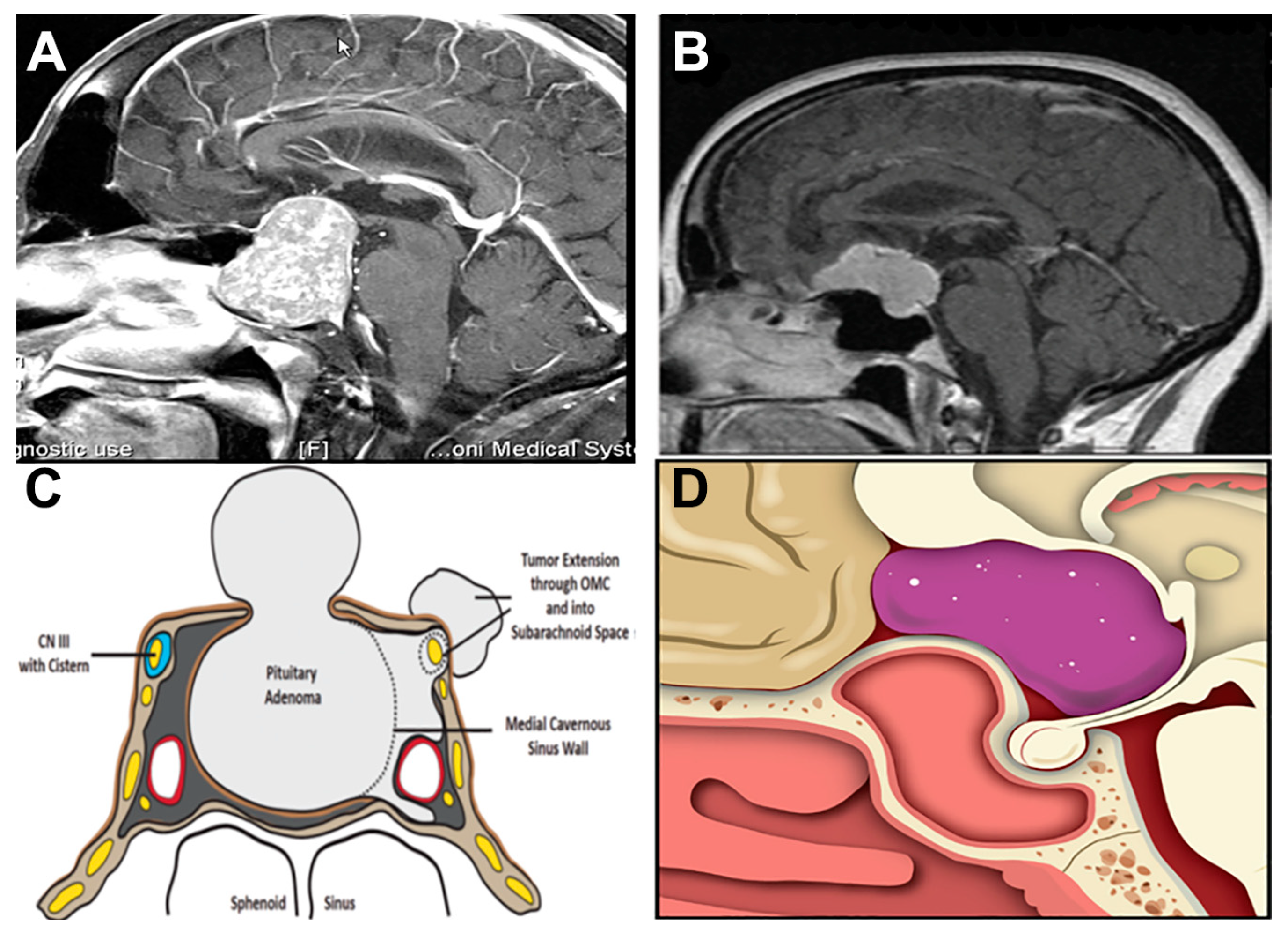
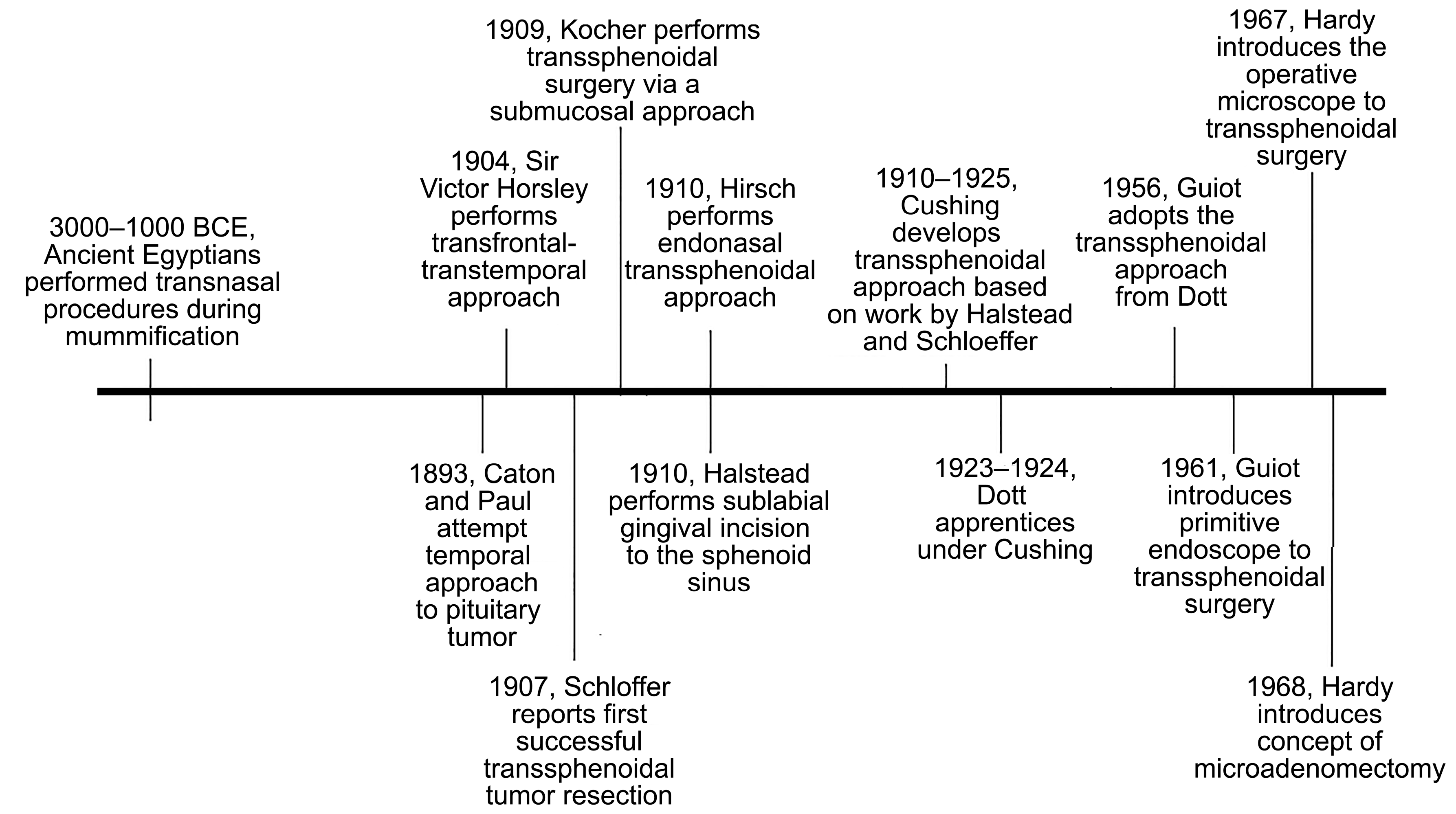

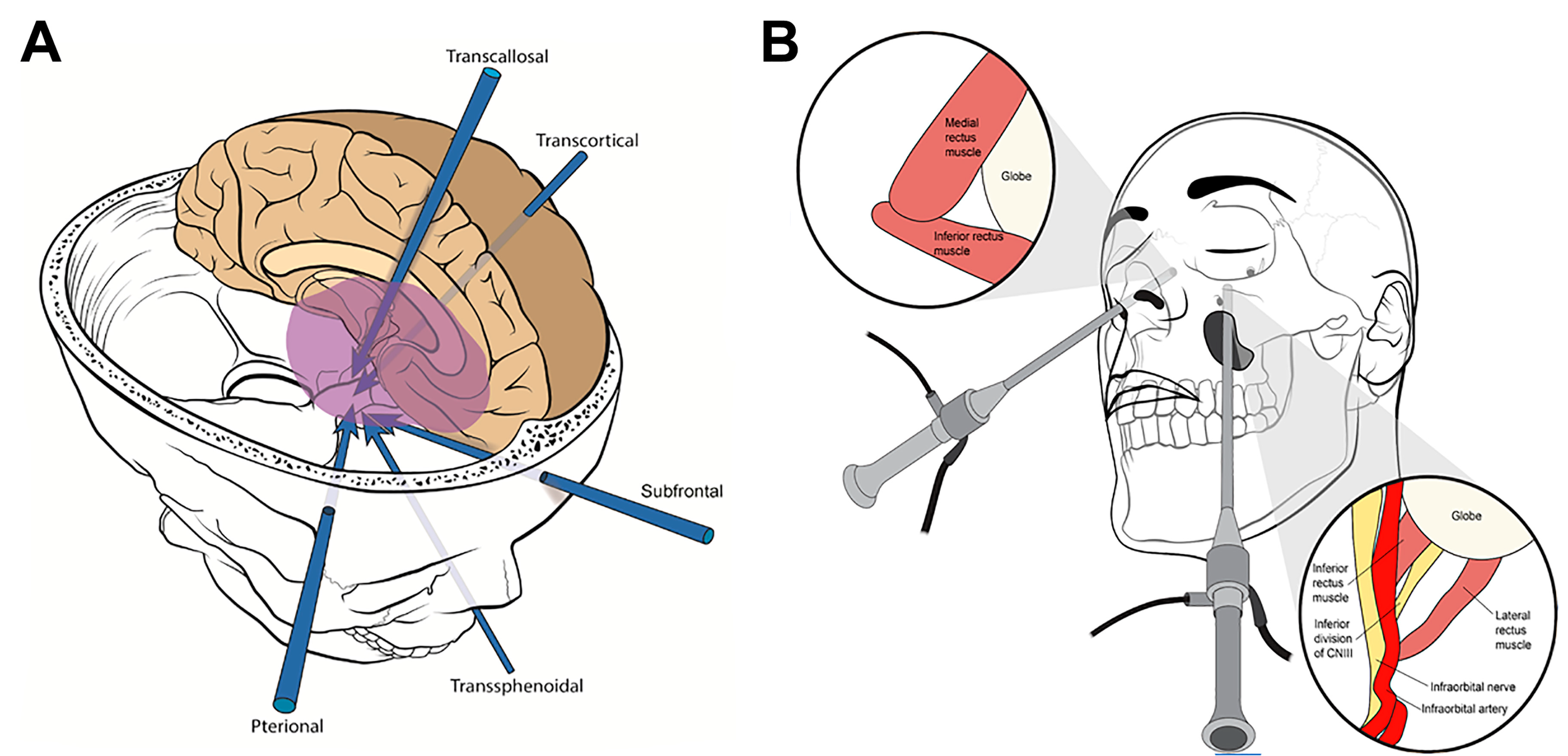
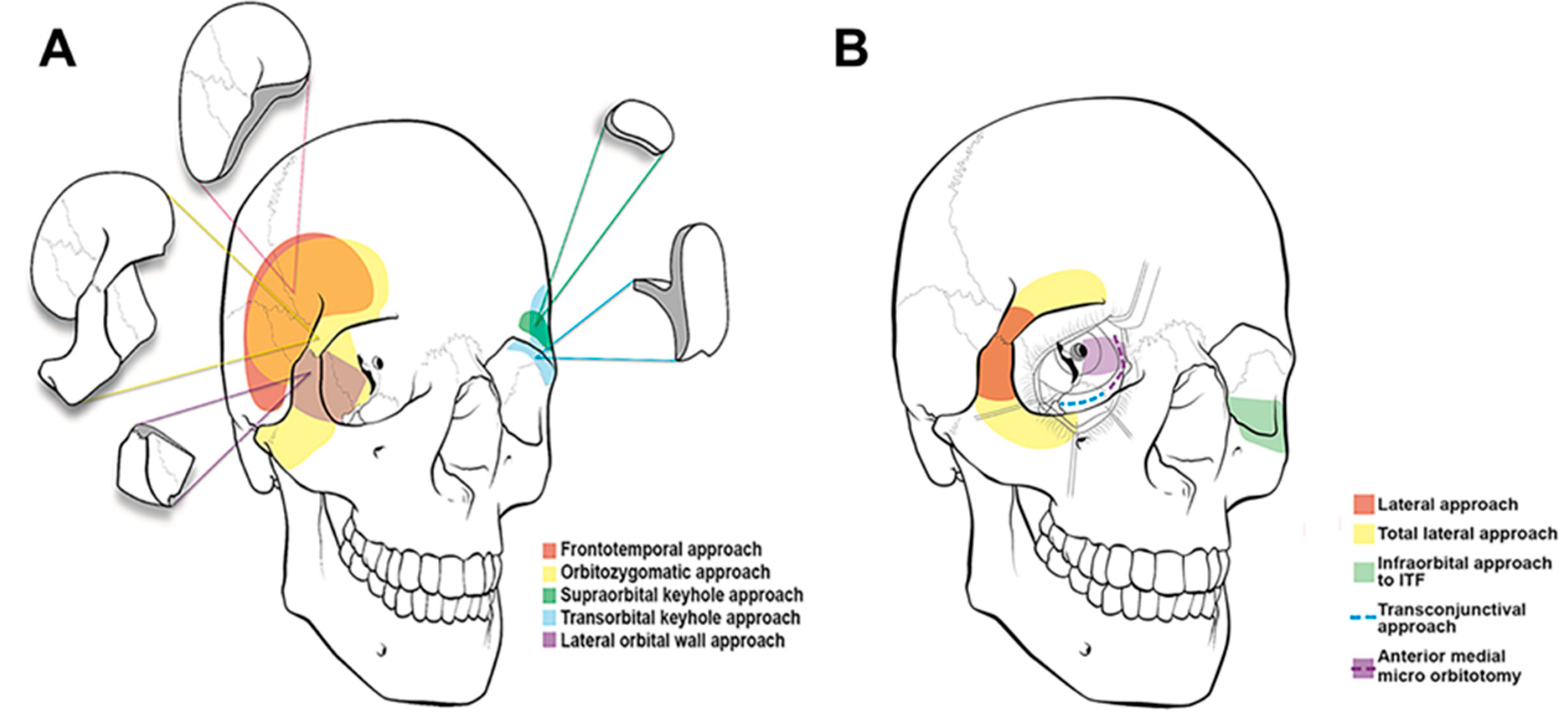
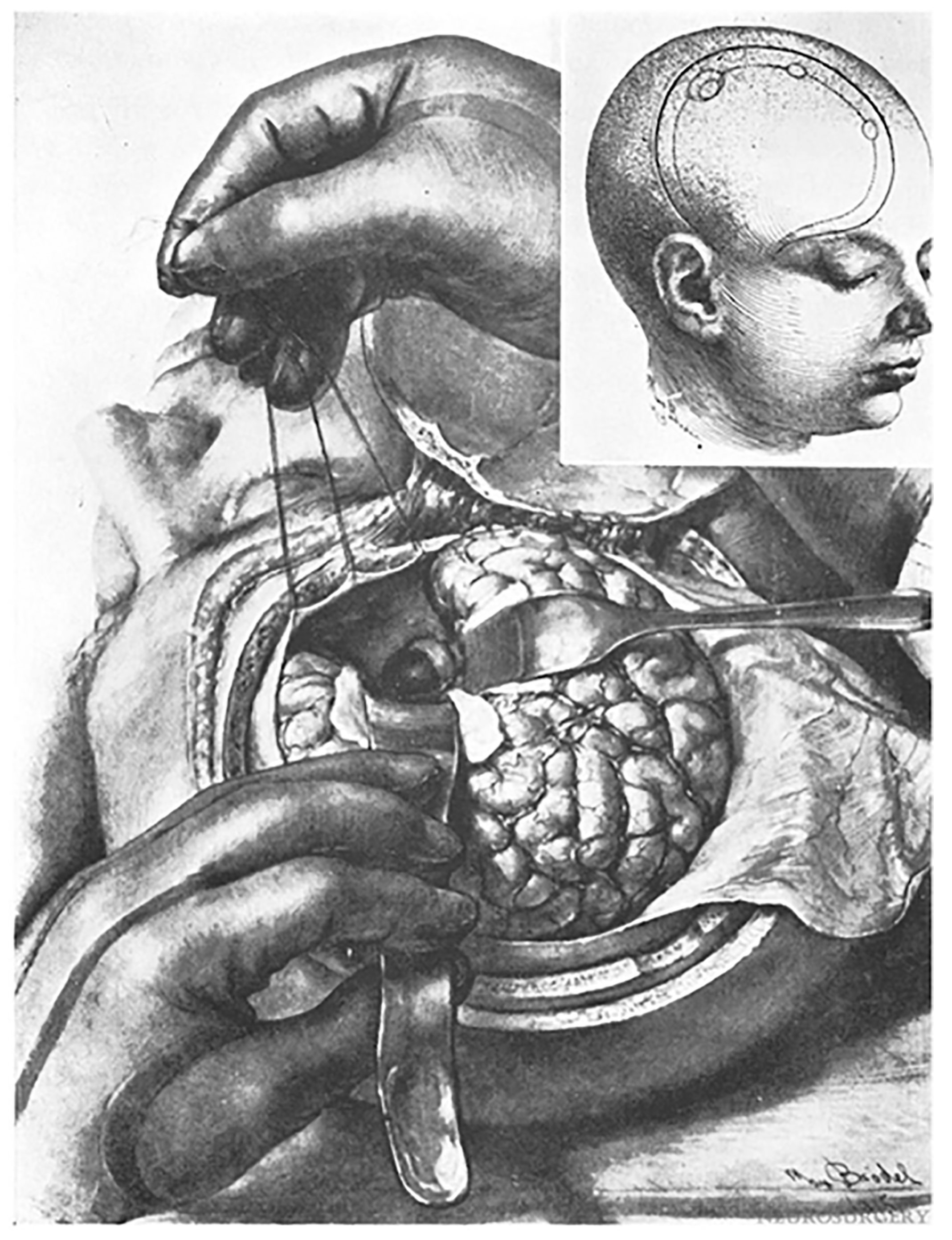
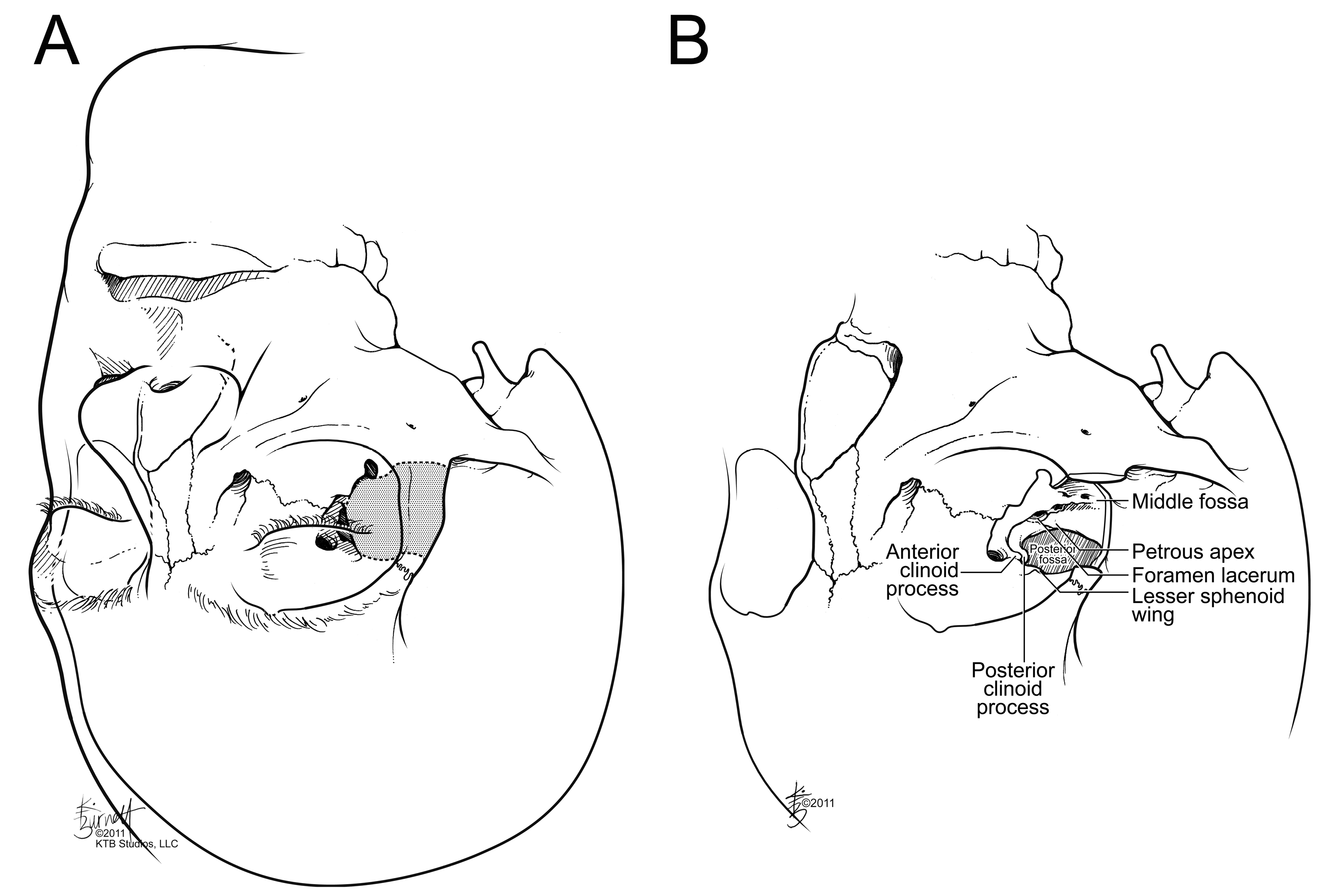
| Approach | Advantages | Disadvantages |
|---|---|---|
| Pterional | Wide angle of exposure, maximal surgical maneuverability, familiarity with approach. Can achieve early vascular control. Versatility, i.e., can manage large, invasive, complex neoplastic and vascular lesions. | Maximally invasive, extensive craniotomies. Longer surgery, hospital stay, and recovery time. Brain retraction injury. Risk of temporalis muscle atrophy and injury to the frontal branch of facial nerve. |
| Frontolateral | ||
| Orbitozygomatic | ||
| Fronto-orbitozygomatic | ||
| Bifrontal craniotomy | ||
| Transsphenoidal | Direct, midline approach to the sella. Versatile, can be performed with microscopic or endoscopic assistance. Superior visual outcomes, no extrinsic cosmetic defects. | Limited to midline and paramedian lesions. Lateral extension/invasion may require a more open approach. Endoscopic surgery requires additional training and specialized equipment. High risk of CSF leak. |
| Lateral supraorbital | Keyhole and minimally invasive approaches. Direct route to lesions. Less blood loss, brain retraction. Lower risk of cosmetic defect. | Requires proper patient selection. Worse surgical maneuverability and more limited operative corridor compared with traditional open surgery. More challenging management of perioperative complications. |
| Supraorbital eyebrow approach | ||
| Lateral orbitotomy | ||
| Supraorbital | ||
| Mini-pterional | ||
| Anterior interhemispheric |
Disclaimer/Publisher’s Note: The statements, opinions and data contained in all publications are solely those of the individual author(s) and contributor(s) and not of MDPI and/or the editor(s). MDPI and/or the editor(s) disclaim responsibility for any injury to people or property resulting from any ideas, methods, instructions or products referred to in the content. |
© 2023 by the authors. Licensee MDPI, Basel, Switzerland. This article is an open access article distributed under the terms and conditions of the Creative Commons Attribution (CC BY) license (https://creativecommons.org/licenses/by/4.0/).
Share and Cite
Rawanduzy, C.A.; Couldwell, W.T. History, Current Techniques, and Future Prospects of Surgery to the Sellar and Parasellar Region. Cancers 2023, 15, 2896. https://doi.org/10.3390/cancers15112896
Rawanduzy CA, Couldwell WT. History, Current Techniques, and Future Prospects of Surgery to the Sellar and Parasellar Region. Cancers. 2023; 15(11):2896. https://doi.org/10.3390/cancers15112896
Chicago/Turabian StyleRawanduzy, Cameron A., and William T. Couldwell. 2023. "History, Current Techniques, and Future Prospects of Surgery to the Sellar and Parasellar Region" Cancers 15, no. 11: 2896. https://doi.org/10.3390/cancers15112896
APA StyleRawanduzy, C. A., & Couldwell, W. T. (2023). History, Current Techniques, and Future Prospects of Surgery to the Sellar and Parasellar Region. Cancers, 15(11), 2896. https://doi.org/10.3390/cancers15112896







